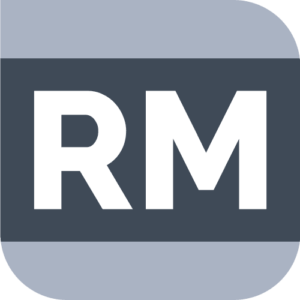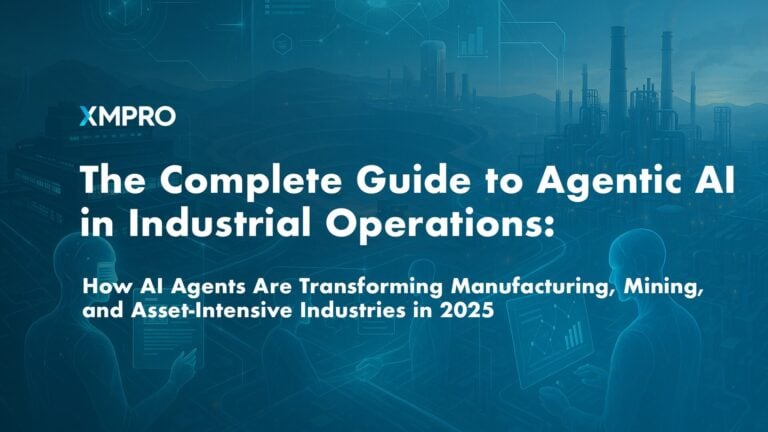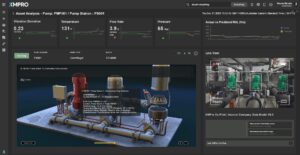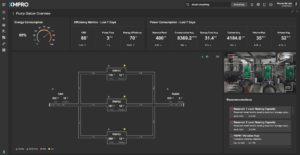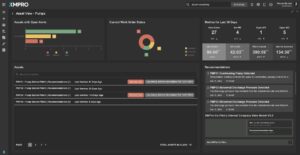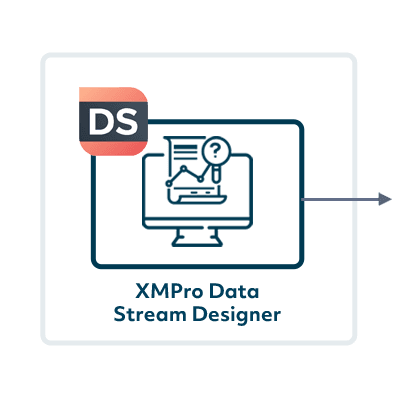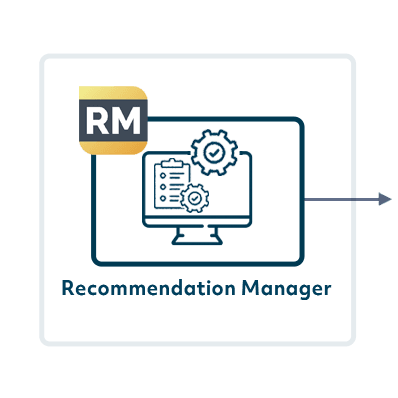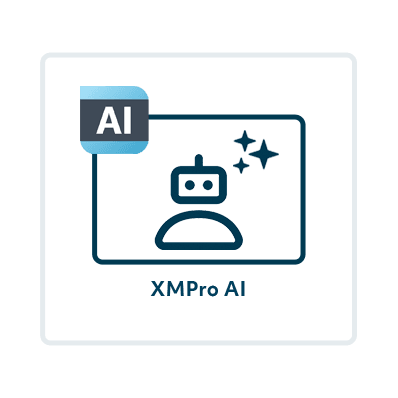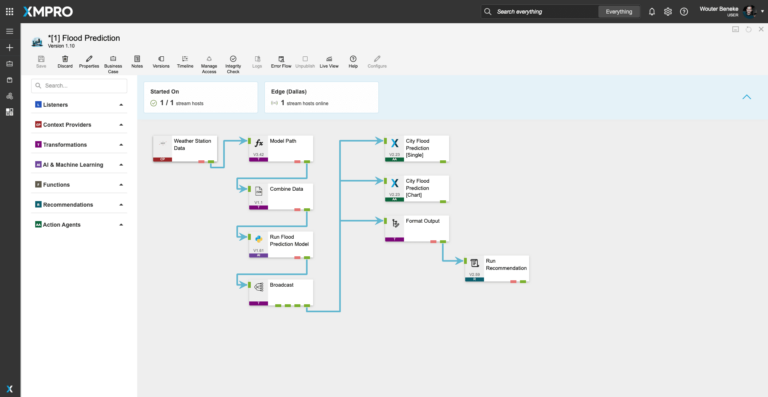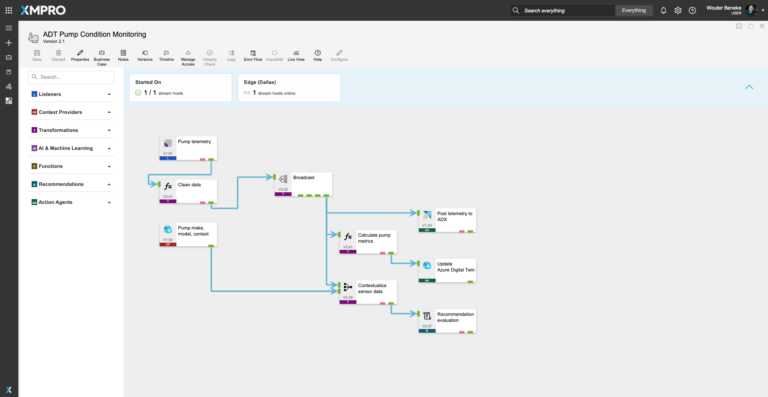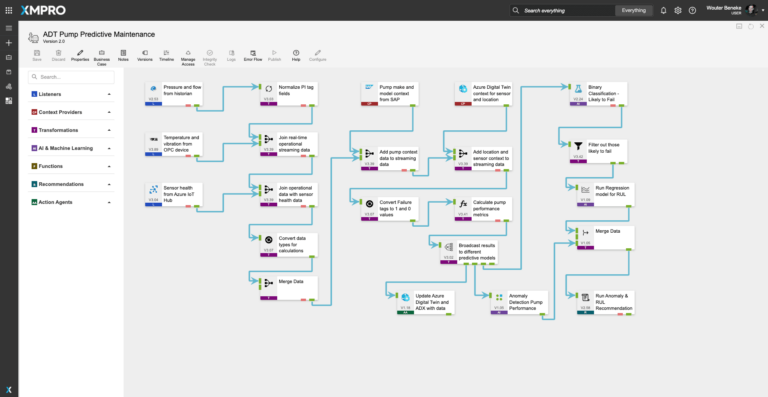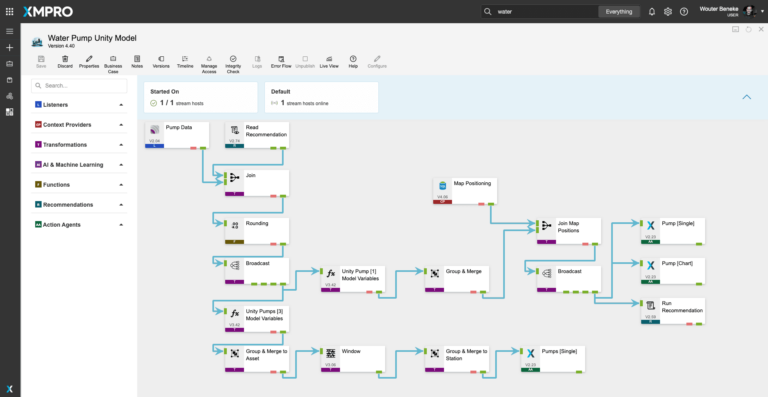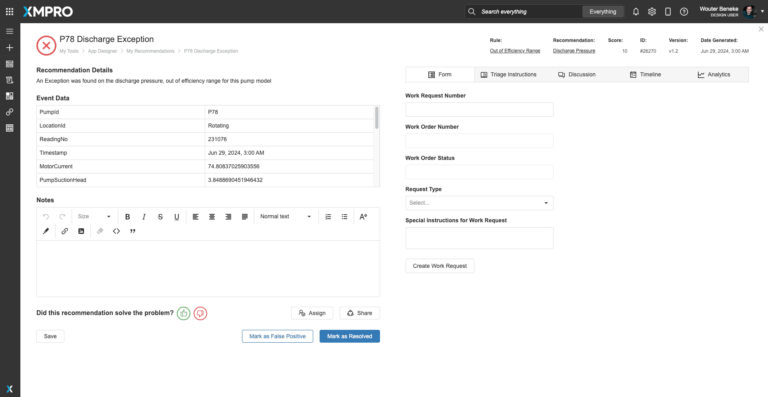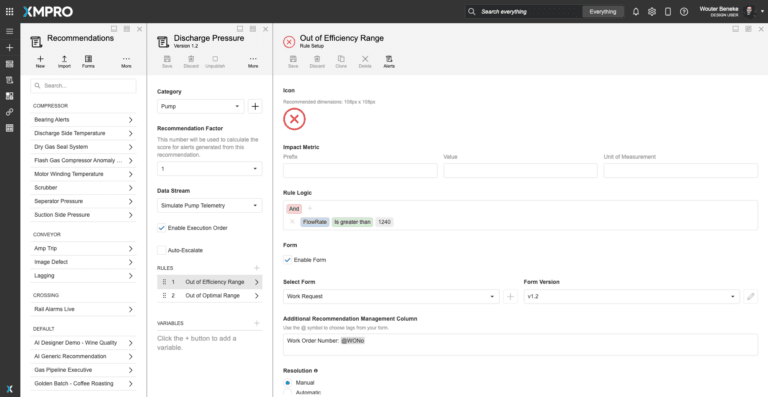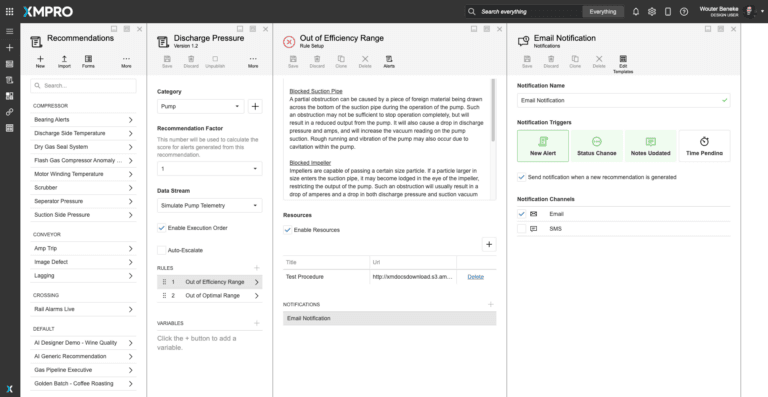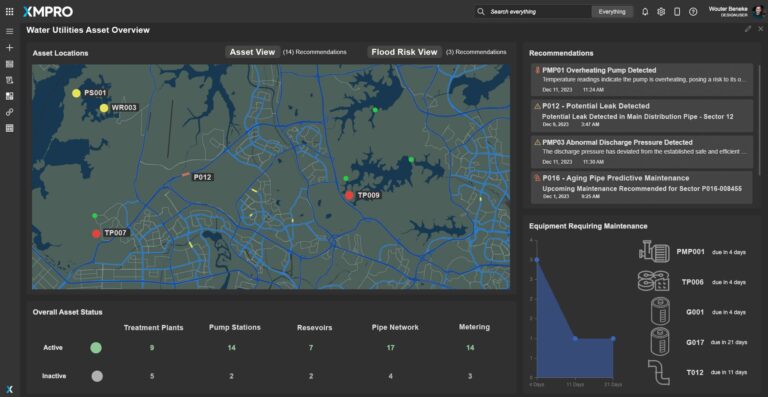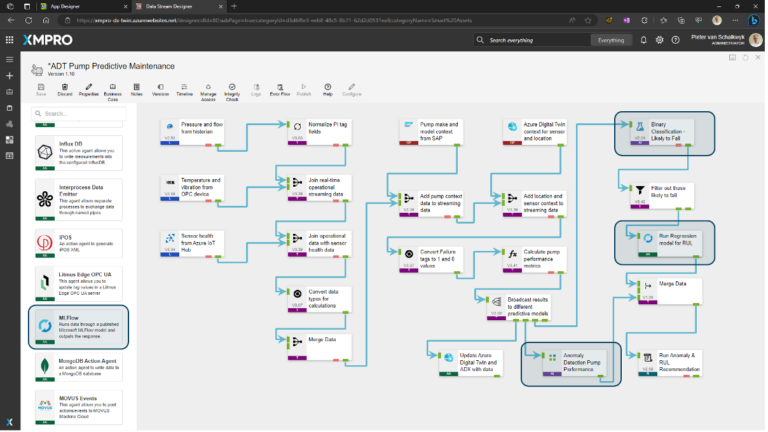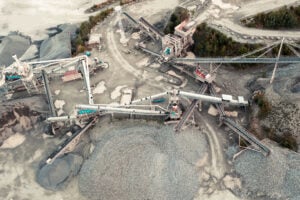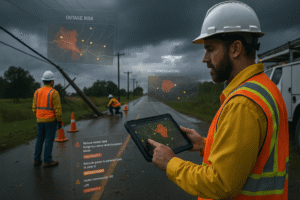Pump Predictive Maintenance in Water Utilities
Introduction
Effective pump operation is crucial for water utilities to ensure reliable water distribution and wastewater management. XMPro’s solution focuses on monitoring pump health to prevent failures and optimize performance.
The Challenge
Water utilities face several challenges in pump operation:
- Early Failure Detection: Identifying signs of wear or impending failure in pump components to prevent breakdowns.
- Efficiency Optimization: Ensuring pumps operate at optimal efficiency to reduce energy consumption and operational costs.
- Maintenance Scheduling: Balancing the need for regular maintenance with minimizing downtime and service disruptions.
The Solution: XMPro iBOS for Pump Predictive Maintenance in Water Utilities
XMPro’s solution effectively manages pump health in water utilities through advanced data integration, predictive analytics, and automated maintenance planning. It integrates real-time sensor data, historical maintenance records, and operational parameters using the Data Stream Designer to monitor pump performance. Machine learning algorithms predict potential pump failures, aiding proactive maintenance scheduling and resource allocation. The system provides real-time monitoring of pump conditions, with alerts for utility operators and maintenance teams. It also coordinates maintenance efforts, including mobilizing crews, scheduling repairs, and managing spare parts inventory. Operational efficiency is enhanced with automated alerts and updates, while configurable dashboards and reporting features support comprehensive analysis and regulatory compliance.
Key Features
- Sensor Data Integration:Utilizing existing sensors to continuously monitor critical pump parameters such as vibration, temperature, flow rate, and pressure. XMPro’s Data Stream Designer integrates this sensor data, providing a comprehensive view of pump performance and condition.
- Predictive Analytics for Maintenance:Implementing machine learning algorithms to analyze sensor data and predict potential pump issues, such as bearing failures or seal leaks. Predictive insights assist in scheduling maintenance activities before issues lead to pump failures.
- Real-Time Monitoring and Alerts:Providing real-time monitoring of pump conditions, with an alert system that notifies maintenance teams of any detected anomalies requiring immediate attention.
- Customizable Dashboards and Reporting:Offering customizable dashboards that present key data on pump health, alongside comprehensive reporting features for maintenance planning and regulatory compliance.
How XMPro iBOS Modules Work Together To Create This Flood Prediction Solution
Discover This Solution In Our Product Tour

XMPro Data Stream Designer
XMPRO’s Data Stream Designer lets you visually design the data flow and orchestration for your real-time applications. Our drag & drop connectors make it easy to bring in real-time data from a variety of sources, add contextual data from systems like EAM, apply native and third-party analytics and initiate actions based on events in your data.
Figure 1: Flood Prediction Data Stream
This flood prediction data stream ingests weather station data to predict potential flooding events. The data is processed through a model path and combined with other relevant data sources. The flood prediction model is then run, and the results are formatted and broadcasted. The data stream generates city flood predictions in both single and chart formats and runs recommendations to provide actionable insights for flood mitigation and response.
Figure 2: Pump Health Condition Monitoring Data Stream
This pump condition monitoring data stream ingests pump telemetry data before cleaning and broadcasting it to various endpoints. The data is contextualized with pump make, model, and operational context. It is then used to calculate pump metrics, post telemetry to ADX, update Azure Digital Twin, and evaluate recommendations.
Figure 3: Pump Predictive Maintenance Data Stream
This pump predictive maintenance data stream ingests pressure, flow, temperature, vibration, and sensor health data from multiple sources before it is normalized and combined with contextual data from SAP and Azure Digital Twin. The integrated data is then used to calculate performance metrics, run predictive models, and update Azure Digital Twin and ADX, enabling the identification of pumps likely to fail and the estimation of their remaining useful life.
Figure 4: Water Pump Unity Model Data Stream
This water pump unity model data stream ingests pump data to monitor and analyze pump conditions. The data is processed and combined with existing recommendations. It is then standardized, broadcasted, and evaluated through the unity pump model. The stream aggregates data by pump assets and stations, incorporates geographical context, and visualizes the data in single and chart formats. Finally, it runs recommendation logic to provide actionable insights for optimal pump performance and maintenance.

Recommendation Manager
XMPRO Recommendations are advanced event alerts that combine alerts, actions, and monitoring. You can create recommendations based on business rules and AI logic to recommend the best next actions to take when a certain event happens. You can also monitor the actions against the outcomes they create to continuously improve your decision-making.
XMPro App Designer
The XMPro App Designer is a no code event intelligence application development platform. It enables Subject Matter Experts (SMEs) to create and deploy real-time intelligent digital twins without programming. This means that SMEs can build apps in days or weeks without further overloading IT, enabling your organization to accelerate and scale your digital transformation.
Figure 1. Real-Time Water Utilities Asset Overview Dashboard
This comprehensive dashboard provides users with an up-to-the-minute view of their water utility assets. It features an interactive map that dynamically updates with the condition of various assets such as treatment plants, pump stations, reservoirs, and the pipe network, offering a clear visual representation of the water distribution system. Each asset on the map is marked with a color-coded status icon, indicating its current operational state, including active status and any alerts or error messages.
The dashboard comprehensively displays the overall status of various asset categories, including treatment plants, pump stations, reservoirs, pipe networks, and metering systems. It also highlights all active recommendations generated by the system’s rule logic. This includes critical alerts like abnormal discharge pressures or potential leaks, ensuring immediate attention to potential issues.
Additionally, the dashboard includes a detailed graph that tracks maintenance requirements across assets. It prioritizes assets based on their upcoming service needs, facilitating efficient maintenance scheduling.
Each section of the dashboard is designed for deeper exploration. Users can drill down into specific asset and recommendation details, gaining granular insights and enabling targeted actions based on the system’s recommendations. This level of detail ensures that users can make informed decisions quickly and maintain optimal operational efficiency in managing water utility infrastructure.
1. Map View of Asset Locations:
- Displays the geographical locations of various assets such as pump stations, treatment plants, reservoirs, and pipeline networks.
- Assets are marked with different colors to indicate their status (e.g., active, inactive, or requiring attention).
2. Asset Status Indicators:
- Shows the overall status of different types of assets, including:
- Treatment Plants: Number of active and inactive treatment plants.
- Pump Stations: Number of active and inactive pump stations.
- Reservoirs: Number of active and inactive reservoirs.
- Pipe Network: Number of active and inactive segments.
- Metering: Number of active and inactive metering points.
3. Recommendations Panel:
- Lists actionable recommendations based on real-time data and predictive analytics, such as:
- PMP01 Overheating Pump Detected: Alerts about pumps that are overheating and pose a risk.
- P012 Potential Leak Detected: Identifies potential leaks in the main distribution pipe.
- PMP03 Abnormal Discharge Pressure Detected: Flags pumps with discharge pressure deviations.
- P016 Aging Pipe Predictive Maintenance: Recommends maintenance for aging pipes.
4. Equipment Requiring Maintenance:
- Visual representation of equipment that needs maintenance, including:
- Pumps, pipes, gauges, and other critical infrastructure.
- Shows the urgency of maintenance with due dates (e.g., PMP001 due in 4 days, TP006 due in 4 days).
5. Graphical Maintenance Schedule:
- A bar graph displaying the maintenance schedule over the coming days and weeks.
- Helps in planning and prioritizing maintenance tasks based on urgency.
6. Detailed Asset View Options:
- Tabs to switch between different views such as Asset View, Recommendations, and Flood Risk View.
- Each tab provides a focused look at specific aspects of asset management and operational risk.
7. Real-Time Monitoring and Alerts:
- Provides real-time monitoring of asset conditions.
- Alerts utility operators about immediate issues that need attention.
8. Comprehensive Data Integration:
- Integrates data from multiple sources including real-time sensor data, historical data, and predictive models.
- Provides a holistic view of the water utility infrastructure for informed decision-making.
Figure 1. Pump Asset Class Drilldown View
This pump asset class drilldown view offers a detailed and actionable overview of pump asset status and maintenance needs within a water utility. It integrates real-time data on performance, alerts, and maintenance schedules, enabling efficient management and timely interventions. Key features include visual representations of open alerts by severity, current work order statuses, and maintenance metrics over the past 30 days. Users can access a searchable list of pump assets, view active recommendations for issues like overheating or abnormal discharge pressure, and leverage the XMPro Co-Pilot for insights and preventative measures.
Alerts Overview: This section graphically displays open alerts related to pump performance and condition, categorized by severity levels – Low , medium, and high severity. This visualization assists in quickly pinpointing pumps that require immediate attention due to potential issues like abnormal vibrations, temperature fluctuations, or efficiency drops.
Work Order Status: The dashboard shows the current status of maintenance activities for pumps, categorized as available (no immediate action needed), in planning (maintenance scheduled), or waiting (urgent maintenance required). This helps in prioritizing maintenance tasks and allocating resources efficiently.
Performance Metrics (Last 30 Days): It summarizes key metrics related to pump health, including new alerts, number of work orders initiated, open work orders, and open work requests. The dashboard also tracks the duration from alert initiation to work order completion, providing a comparative analysis with the previous 30-day period.
Pump Filtering and Maintenance Information: Users can filter and view specific pumps, accessing detailed information such as the last maintenance date, upcoming scheduled maintenance, and due dates. This feature is crucial for planning preventive maintenance and avoiding unexpected downtimes.
Recent Recommendations: This area lists the latest recommendations generated for pump maintenance, based on predictive analysis and real-time monitoring data. Users can view detailed information for each recommendation and take proactive steps to address potential issues.
XMPro Co-Pilot Integration: The dashboard includes an interactive XMPro Co-Pilot feature, where users can input queries related to pump maintenance or operational issues. The AI model, trained on relevant internal data such as pump specifications and historical performance data, provides specific guidance on addressing identified issues. This advice can be directly linked to work order requests and triage instructions.
This Asset Drill Down View is tailored for effective pump management in water utilities, enabling operators to swiftly access critical information, make informed decisions, and ensure the optimal performance and reliability of their pump assets.
Figure 3. Pump Health Asset Analysis View
This pump health asset analysis view provides a detailed and real-time assessment of pump performance and condition. It integrates various metrics and live visuals to enable proactive maintenance and efficient management. Key features include real-time data on vibration deviation, temperature, flow rate, and pressure, along with actual vs. predicted remaining useful life (RUL). Users can view a 3D model of the pump, monitor live video feeds, and receive actionable insights and recommendations from XMPro Co-Pilot.
This Asset Analysis View offers detailed insights into specific pumps within the water utility system, focusing on a particular pump identified as Pump PMP001
Comprehensive Pump Health Metrics: This section displays vital health indicators for Pump PMP001, including vibration levels, temperature, flow rate, and pressure. Real-time data is combined with predictive analytics, enabling forecasts of potential issues and aiding in proactive maintenance.
Interactive 2D and 3D Pump Models: The dashboard presents detailed 2D and 3D models of Pump PMP001, with features that allow for an expanded view of specific components. Areas flagged for potential wear or failure, such as impeller degradation or seal leaks, are highlighted for quick identification. For instance, components showing abnormal vibration or temperature readings are distinctly color-marked.
Error Identification and Proactive Recommendations: Clickable sections in the pump model lead users to specific error details and associated recommendations. This integration with XMPro’s Recommendation Manager streamlines the process for identifying and addressing pump-related issues.
Detailed Information on Pump PMP001: The dashboard provides a comprehensive profile of Pump PMP001, including its type, operational history, and unique characteristics. This information is crucial for understanding its maintenance and operational requirements.
XMPro Co-Pilot Integration: Incorporating XMPro Co-Pilot, this feature utilizes AI, trained on datasets such as historical performance data and maintenance records, to offer specific guidance for issues related to Pump PMP001. This AI-driven assistance supports informed decision-making and enhances the efficiency of maintenance processes.
This Asset Analysis View is specifically designed to provide a complete picture of the health of Pump PMP001, combining sophisticated visual models with data-driven insights and AI-powered recommendations for effective pump management in the water utility industry.

XMPro AI
Experience the transformative power of XMPro’s Intelligent Business Operations Suite (iBOS) – Featuring comprehensive AI capabilities, XMPro iBOS helps to significantly increase product yield, drastically reduce downtime, and ultimately eliminate unexpected business events.
Figure 1: Embedded AI Example – Pump Predictive Maintenance
Embedding XMPro AI Agents in XMPro Data Streams enables executable AI and machine learning for algorithmic business processes, significantly enhancing the capabilities of operational digital twins. This integration allows for advanced features such as real-time analytics, MLOps, and the seamless embedding of AI into core business processes.
In the example of pump predictive maintenance, XMPro’s AI Agents empower the data stream to accurately forecast potential pump failures. The process begins with the ingestion of real-time sensor data, including pressure, flow, temperature, vibration, and sensor health, combined with historical maintenance records and operational context. The data is normalized and contextualized with pump make and model information, and location data from digital twins. Machine learning models, including binary classification and regression, are applied to predict failure likelihood and remaining useful life (RUL). The results are filtered, merged, and broadcasted for further action. The data stream generates actionable insights for maintenance scheduling and resource allocation, ensuring optimal pump performance and minimizing downtime.
Embedded AI Agents
XMPro offers a variety of AI agents to support diverse operational needs, including:
- Azure OpenAI: Enhances natural language processing capabilities.
- OpenAI Assistant: Facilitates conversational AI integrations.
- Anomaly Detection: Identifies unusual patterns in data to prevent operational failures.
- Forecasting: Predicts future trends based on historical data.
- Kmeans Clustering: Groups similar data points for more effective analysis.
- MLflow: Manages the machine learning lifecycle, including experimentation, reproducibility, and deployment.
- Regression: Provides predictive analytics to understand relationships between variables.
By embedding these powerful AI agents, XMPro transforms AI models into valuable assets that drive business growth and efficiency, bridging the gap between data flow and operational AI.
Use XMPro Blueprints for Quick Time To Value
Easily import Blueprints, Accelerators and Patterns into your environment, providing a starting point for configuring your own solutions.
Why XMPro iBOS For Pump Health Monitoring in Water Utilities?
XMPro’s Intelligent Business Operations Suite (iBOS) is uniquely equipped to address the complexities of Pump Health Monitoring in the water utilities industry, utilizing cutting-edge technology and analytics. Here’s how XMPro iBOS excels in this application:

Intelligent Digital Twin Creation for Pumps:
XMPro iBOS can create a digital twin of each pump, providing a virtual representation that mirrors the real-world conditions of the pump. This digital twin continuously updates with data from sensors, allowing for real-time monitoring and analysis.
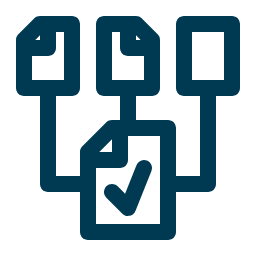
Advanced Sensor Data Integration & Transformation:
The suite integrates data from various sensors installed on pumps, such as vibration, temperature, flow rate, and pressure sensors. XMPro’s ability to aggregate and interpret this data is key to monitoring pump health and identifying potential issues early.
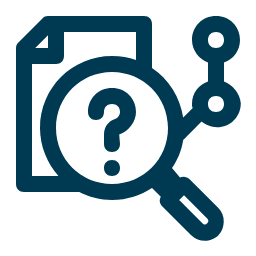
Predictive Analytics for Early Warning:
Utilizing machine learning algorithms, XMPro iBOS analyzes historical and real-time sensor data to predict potential pump failures or maintenance needs. This predictive capability allows for proactive maintenance scheduling, reducing downtime and preventing catastrophic failures.
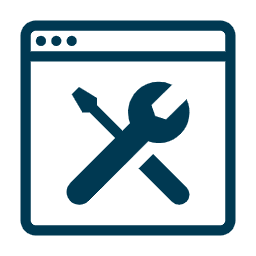
Maintenance Scheduling Optimization:
The suite helps optimize maintenance schedules based on actual pump conditions and predictive insights, shifting from a reactive to a proactive maintenance approach.
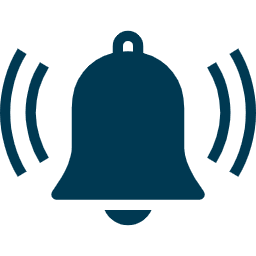
Real-Time Alerts and Proactive Decision Making:
XMPro iBOS provides real-time monitoring of pump conditions. It can generate instant alerts when parameters like temperature or vibration exceed predefined thresholds, as in the case of an overheating pump.
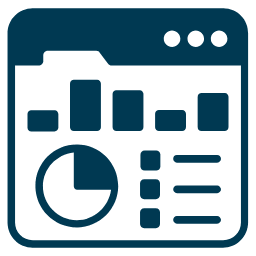
Customizable Dashboards for Enhanced Decision-Making:
XMPro iBOS includes configurable dashboards that display key pump health data in an easy-to-understand format. These dashboards can be tailored to the specific needs of water utility operators, providing them with actionable insights.

Scalability and Flexibility – Start Small, Scale Fast:
XMPro iBOS is scalable and flexible, capable of adapting to projects of all sizes, from single asset solutions, to comprehensive Common Operating Pictures of multiple asset classes.
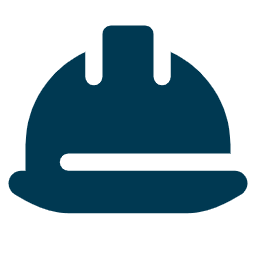
Enhanced Safety and Operational Efficiency:
XMPro iBOS provides decision support tools that help prioritize maintenance activities based on the severity and urgency of detected issues.
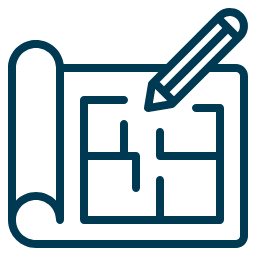
Quick Time To Value – XMPro Blueprints
Utilize XMPro blueprints, pre-configured for pump health monitoring to quickly set up the digital twin dashboard. These blueprints integrate industry best practices, ensuring a swift and effective implementation.
In summary, XMPro iBOS addresses the pump health monitoring use case by offering a comprehensive, real-time, predictive, and integrated solution. Its capabilities in creating digital twins, advanced sensor data integration, predictive analytics, and customizable dashboards make it a powerful tool for enhancing the reliability and efficiency of pump operations in water utilities.

Not Sure How To Get Started?
No matter where you are on your digital transformation journey, the expert team at XMPro can help guide you every step of the way - We have helped clients successfully implement and deploy projects with Over 10x ROI in only a matter of weeks!
Request a free online consultation for your business problem.
"*" indicates required fields




